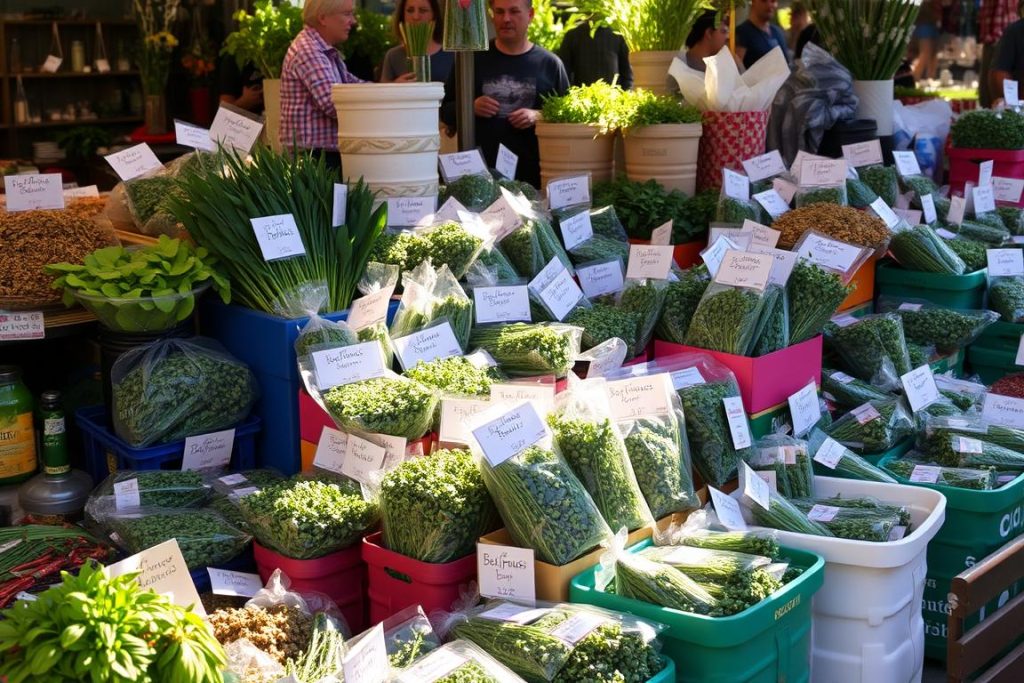I love cooking at home and found Beifuß herb, also known as Artemisia vulgaris or mugwort. It’s a key part of German cooking. It adds a special bitterness that goes well with rich foods.
If you want to try Beifuß in your cooking, you have a few ways to get it.
You can buy Beifuß online at places like eBay. There, you can find Beifuß gemeiner (common mugwort) for about €16.80. They also ship it internationally.
Specialty herb shops like 1000Kräuter sell Beifußsträußchen (bundles of Beifuß) for $4.20. These are great for adding to meals to help with digestion.
Understanding Beifuß: An Essential Culinary Herb
Beifuß, also known as Besenkraut, is a plant used for centuries. It belongs to the Asteraceae family and is found in Europe and Asia. It’s loved for its unique smell and taste.
Traditional Uses in German Cuisine
In German cooking, Beifuß is very important. It’s used to flavor roasted goose, especially at Christmas. It also adds a special taste to sauerkraut.
Health Benefits and Properties
Beifuß is good for cooking and health. It’s called a Heilpflanze and Heilkräuter because of its health benefits. Its oil has compounds that fight insects and reduce inflammation.
Identifying Fresh Beifuß
To find fresh Beifuß, look for its unique look and smell. It has special leaves and flower clusters. It grows to be 70 to 150 cm tall.
Knowing about Beifuß helps you use it in your cooking. It’s a key herb in German and European dishes.
Online Marketplaces for Authentic Beifuß
Looking for fresh Beifuß herb for cooking? Online marketplaces are a great choice. eBay, a big e-commerce site, has many listings from Germany. Sellers like one in Grabenstätt offer real Artemisia vulgaris for shipping worldwide.
1000Kräuter in Werl, Germany, is another great place. They sell Beifußsträußchen, or Beifuß bundles, in sets of 5. They have over 10 sets, with 10 already sold. This shows how popular Beifuß is among international buyers.
| Marketplace | Location | Product | Availability | Shipping |
|---|---|---|---|---|
| eBay | Grabenstätt, Germany | Artemisia vulgaris (Beifuß) | Available | International |
| 1000Kräuter | Werl, Germany | Beifußsträußchen (Beifuß Bundles) | More than 10 available, 10 sold | International |
These online shops make it easy for cooks and chefs worldwide to get Beifuß. They help bring the real taste of German food to kitchens everywhere.
Local European Specialty Stores and Suppliers
Looking for Beifuß? Check out local European stores and international markets. They have many German herbs and spices. You can find fresh Beifuß there.
German Delicatessens
German Delis are great for finding German food. They have sausages, cheeses, and baked goods. They also have fresh Beifuß.
These Delis get their Beifuß from Germany. This means you get the best quality.
International Food Markets
International food markets are also good for Beifuß. They have herbs, spices, and more from all over. It’s fun to explore and find new foods.
| European Specialty Stores | German Food Shops | International Grocers |
|---|---|---|
| La Maison du Monde | Aldi | Carrefour |
| Marks & Spencer | Lidl | Tesco |
| Harrods | REWE | Walmart |
Visit these stores and markets. You’ll find real Beifuß flavors. It’s a great way to try new foods.
Seasonal Availability and Harvesting Times
Knowing when Beifuß is in season is key to getting the best herb. This info helps you know when to buy or pick fresh Beifuß for cooking.
The mugwort season starts in late spring and goes into summer. This is when Beifuß is at its best, with tasty leaves and flowers. The best time to pick Beifuß is mid-to-late summer, when it’s most flavorful.
- Spring (late spring to early summer): Beifuß starts growing, with leaves and flowers getting their taste and smell.
- Summer (mid-to-late summer): This is the best mugwort season, with Beifuß at its peak in taste and quality.
- Fall (early fall): As it gets cooler, Beifuß plants start to fade, ending the mugwort season.
Knowing these seasons helps you get the freshest and tastiest Beifuß for your cooking.
Quality Indicators When Purchasing Fresh Beifuß
When you buy fresh Beifuß for cooking, look for important signs. These signs help you get the best herb. You should check the look, smell, and feel of the Beifuß.
Visual Inspection Tips
The look of Beifuß tells you a lot. It should be bright green and look healthy. Stay away from wilted or damaged leaves. They show the herb is not fresh.
The stems should be strong and straight. If they are weak or bent, the herb is not good.
Aroma and Texture Guidelines
The smell and feel of Beifuß are also key. Fresh Beifuß should smell strong and earthy. The leaves should be firm and crunchy.
If the leaves are soft or the smell is weak, the Beifuß is old. Paying attention to these signs helps you pick the best Beifuß. This way, you can enjoy its great taste and smell.
Price Ranges and Package Sizes
Buying fresh Beifuß, or mugwort, can vary in cost and package sizes. The price depends on the source, amount, and quality.
On eBay, you can find Beifuß gemeiner (common mugwort) for about €16.80 (around $18.02) per bundle. These bundles have a lot of fresh herb. They are great for home cooks because they are affordable and convenient.
If you need less, stores like 1000Kräuter sell Beifußsträußchen (mugwort bunches) in packs of 5. These small bundles are perfect for your recipes. Prices start at $4.20.
| Product | Package Size | Price |
|---|---|---|
| Beifuß gemeiner (Common mugwort) | Bundle | €16.80 (~$18.02) |
| Beifußsträußchen (Mugwort bunches) | Pack of 5 | Starting at $4.20 |
Whether you want a lot or a little, there are many options for fresh Beifuß. Knowing the prices and sizes helps you choose what fits your needs and budget. This way, you can pick the best herb for your cooking.

Shipping and Storage Considerations
Enjoying fresh Beifuß herb needs the right shipping and storage. Buying Beifuß from abroad might mean dealing with customs. But, with the right steps, your herb will arrive perfectly.
International Shipping Requirements
Shipping fresh herbs like Beifuß internationally can have extra costs. DHL Paket International is a good choice for around €9.90 (about $10.62 USD). Knowing and following rules helps you get this special herb from around the world.
Proper Storage Methods
Keeping Beifuß fresh after buying is key. Here’s how to store it well:
- Wrap Beifuß stems in a damp paper towel and put them in a sealed bag or container.
- Keep the herb in the fridge for up to 5 days.
- Don’t let Beifuß get too hot or sunny, as it can wilt and lose smell.
- To keep it longer, dry or freeze Beifuß.
Good shipping and storage keep Beifuß fresh. This lets you enjoy its unique taste and smell fully.
Growing Your Own Beifuß at Home
Growing Beifuß, also known as mugwort or Artemisia vulgaris, is rewarding. It adds flavor to German dishes and has health benefits. Having Beifuß at home means you always have fresh herbs.
Beifuß loves well-drained soil and lots of sun. You can grow it in gardens or pots. Make sure the soil is rich with compost or manure for it to grow well.
- Sow Beifuß seeds after the last frost, or start indoors and move them outside when big enough.
- Plant them 18-24 inches apart for good air and growth.
- Keep the soil moist but not too wet.
- Trim the plants to keep them bushy and flavorful.
Harvest Beifuß in late summer or early fall. Cut off leaves or stems, leaving some for more growth. Dry and store it well to enjoy its flavor all year.
| Cultivation Tip | Benefit |
|---|---|
| Grow Beifuß in well-drained, nutrient-rich soil | Promotes robust growth and optimal flavor development |
| Prune or deadhead the plants regularly | Encourages bushier growth and prevents premature flowering |
| Harvest Beifuß before flowering | Preserves the herb’s aromatic compounds and culinary qualities |
Growing Beifuß at home gives you a steady supply of this key herb. It also lets you grow a piece of German culinary history. Enjoy the fresh, fragrant Beifuß in your cooking.
Popular Beifuß Vendors and Their Offerings
Online places like eBay are great for finding fresh Beifuß. A seller in Grabenstätt, Germany, is very popular. People love their Beifuß because it’s high quality and pure.
Top-Rated Sellers
Specialty stores like 1000Kräuter in Werl, Germany, are also known for their Beifuß. They ship fast, package well, and grow their herbs organically. This makes them very popular with customers.
Customer Reviews and Ratings
Choosing a good Beifuß vendor is important. Look at what other customers say. Many sellers have happy customers who say their Beifuß is great.
| Vendor | Location | Product Offerings | Customer Ratings |
|---|---|---|---|
| eBay Seller | Grabenstätt, Germany | Dried Beifuß leaves, powder, tincture | 4.9/5 stars (300+ reviews) |
| 1000Kräuter | Werl, Germany | Certified organic Beifuß, various forms | 4.8/5 stars (200+ reviews) |
When you buy Beifuß, choose vendors who care about quality and customer happiness. This way, you get the best Beifuß for cooking and health.

Alternative Names and Varieties
Beifuß, also known as Artemisia vulgaris, mugwort, or common wormwood, is an herb with a rich history. It has many names and varieties. This helps us see its uses in cooking and medicine.
Artemisia vulgaris comes from temperate Europe, Asia, North Africa, and Alaska. It’s also found in North America. Some see it as an invasive weed, but it’s valued for its smell and traditional uses.
- In Vietnam and Germany, Artemisia vulgaris is used in cooking.
- In China, young Artemisia vulgaris shoots are used in stir-fries.
- In Nepal, Artemisia vulgaris, or mugwort, is used for cleaning and as medicine.
- The dried leaves are smoked or made into tea to help with dreaming.
Artemisia vulgaris has 89 names in different languages. In English, it’s called chrysanthemum weed, common mugwort, and common wormwood. Spanish and Catalan have many names too, like altamisa and herba de Sant Joan.
Despite its many names, Artemisia vulgaris is a key herb worldwide. It’s important in cooking and medicine, with a rich history and cultural value.
Preparing and Using Fresh Beifuß in Recipes
Fresh Beifuß, also known as mugwort, is key in German cooking. It adds a unique flavor to many dishes. Its taste is grassy and slightly bitter, great for making heavy foods easier to digest.
To get ready for cooking, wash and dry the leaves gently. Use the young leaves for the best taste. You can chop, tear, or leave them whole, depending on your recipe.
Beifuß is often used in sausages and meat dishes in German cooking. It balances the meat’s richness and helps with digestion. It’s also good on roasted meats like goose or pork, adding a special flavor.
Beifuß is also great in vegetable dishes. It goes well with potatoes, cabbage, and root veggies. It adds an earthy and peppery taste. Try sautéing it with onions and garlic, or add it to soups and stews for a nice herbal flavor.
Beifuß can also make your salads or dishes look and taste better. Its green leaves and flowers add elegance and freshness. They make any meal more enjoyable.
Beifuß is a great herb to try in your cooking, whether you’re making traditional German dishes or just want to try something new. It can make your food taste better and make meals more fun.
Import Regulations and Customs Information
When you bring in Beifuß, or mugwort, you might face customs checks. You could also deal with duties, taxes, and fees. Sellers must follow laws and tell the truth about the item’s value.
Shipping herbs across borders is tricky. There are many herb import rules and customs regulations to follow. The rules change based on where the herb comes from and where it’s going. It’s key for buyers and sellers to know these laws well.
Customs offices can give you the details on import regulations and what you need to bring herbs like Beifuß. Knowing these rules can help avoid delays. This ensures your herbs arrive on time.
| Regulation | Description |
|---|---|
| EU Treaty | Upholds the free movement of goods, allowing foodstuffs legally on the market in one EU member state to be imported and marketed in others. |
| German Food and Feed Code (LFGB) | Requires products not compliant with health protection laws to obtain marketability confirmation through a general disposition published in the Federal Gazette under §54. |
| Official Controls Regulation (EU) 2017/625 | Harmonizes rules for imports into the EU, especially for goods subject to increased controls like mycotoxins, pesticide residues, and microbial contamination. |
| Implementing Regulation (EU) 2019/1793 | Replaced older regulations, setting minimum requirements for border control posts and controls on food and feed of non-animal origin from third countries. |
By knowing the customs regulations and following the right import procedures, you can ship Beifuß and other herbs successfully. This makes sure everything goes smoothly.
Conclusion
Getting fresh Beifuß, or Artemisia vulgaris, is fun for home cooks and food lovers. You can find it online, in European stores, or grow it yourself. The goal is to get the best Beifuß for your German and European dishes.
This guide has shown you how to use Beifuß, its health perks, and how to spot it. Knowing when it’s in season, how to check its quality, and how to store it helps. This way, your Beifuß will always add great taste and smell to your German food.
Keep trying new things with fresh Beifuß in your cooking. It can make your dishes even better. Whether you’re making classic meals or adding a German twist, Beifuß is a great choice. Enjoy finding and using Beifuß in your cooking!



